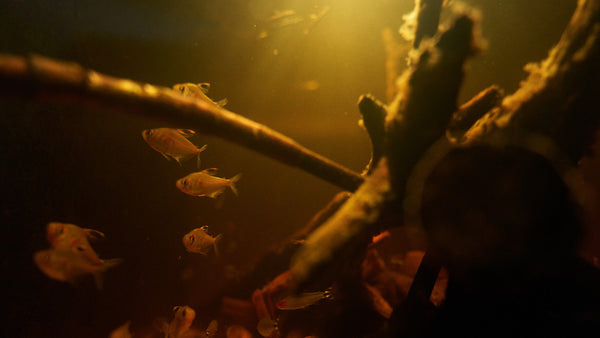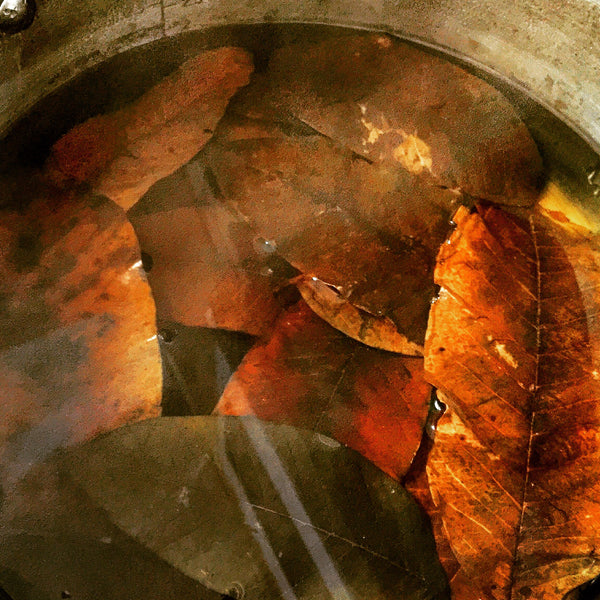- Continue Shopping
- Your Cart is Empty
This is How I do It (Pt. 2)
So, apparently, my first "installment" of "This is How I do It" proved to be pretty popular. I have literally had non-stop emails and dm's from people asking for more. I guess I may as well continue, huh?
Yeah.
So, let's talk about how I use botanicals in MY tanks.

Not, which ones I use, although I can give you my two cents on that topic- but more on how I use them. How I prepare them, how many I tend to use, etc.
We can start with my thoughts on selection.
That's the "million dollar question", because it varies. I have personal tastes and ideas behind my selections. Many hobbyists choose specific botanicals because they offer shelter or hiding spaces for fishes, or help create spawning sites, foraging areas, etc., etc., etc. So, it's impossible for me to say that I use a specific botanical in every tank I play with.
Yeah, it varies.
Okay, here's one generality: Personally, I do like smaller botanicals in most of my tanks. I tend to select smaller ones, because they provide a sense of scale. Larger botanicals just look better in larger tanks, IMHO.

I like the smaller stuff, because it better fits most of the "themes" I play with. It fits the "scale" of the tanks I work with.

The other thing I typically tend to do is utilize a relatively small diversity of materials in any given tank. It's a personal preference thing based upon my tastes, but people ask a lot. So, for example, I may choose only one or two types of seed pods in a given tank.

Now, with leaf litter beds, I'm a big fan of diversity! In most of the leaf litter beds I've been to and seen in Nature, there is a fair amount of diversity. It's a good model for us.

Yet, there are certainly other times when a wide variety of stuff is important. It's part of the big idea, so I totally get this. It's subjective for sure. And, as is demonstrated by great aquascapers like our friend Cory Hopkins, it's beautiful to adeptly and beautifully blend many different materials into one cohesive scape.

And of course, in some of my scopes, like my "Igapo" and "Varzea" concepts, I will typically use a lot of different stuff.

And then there's the surprisingly "controversial" process of preparation. I get a lot of questions about this. Even after five years of trying to elevate the art and science, there's still confusion, misunderstanding, and even some "regurgitation" of "recommendations" proffered by people who have never even tried this stuff.
It's weird.
"Fellman, you're really into boiling and stepping them, huh?"
Yes. I am.
"Why do you do that?"
Botanicals and leaves are collected from various locations around the world; typically as naturally fallen and dried. When these materials fall on the ground, they can be exposed to stuff like spiders and their webs, bird droppings, dust, and good old-fashioned dirt.

Look, I'm big on utilizing all sorts of stuff in my tanks to foster biodiversity and bacterial growth, etc., but I don't want bird shit and spider webs in my tank! This is stuff which, in the confines of an aquarium, could introduce unwanted organisms and contribute to the degradation of the water quality.
So I give my botanicals a good rinse. Then I boil or steep them.
"Isn't that overkill?"
I don't think so.
Consider that boiling water is used as a method of making water potable by killing microbes that may be present. Most nasty microbes "check out" at temperatures greater than 60 °C (140 °F). For a high percentage of microbes, if water is maintained at 70 °C (158 °F) for ten minutes, many organisms are killed, but some are more resistant to heat and require one minute at the boiling point of water. (FYI the boiling point of water is 100 °C, or 212 °F)...But for the most part, most of the nasty bacteria that we don't want in either our tanks or our stomachs are eliminated by this simple process.
So, wouldn't it make sense to boil our botanicals before we dump them into our aquariums?
Yeah, it would.
Ten minutes of boiling is "golden", IMHO. Of course, we boil for other reasons, too-as we'll touch on now.
Boiling also serves to soften botanicals. Softening them helps them sink more quickly in our aquariums. No one seems to like a bunch of leaves and seed pods floating around, right?
If you remember your high school Botany (I actually do!), leaves, for example, are surprisingly complex structures, with multiple layers designed to reject pollutants, facilitate gas exchange, drive photosynthesis, and store sugars for the benefit of the plant on which they're found.
As such, it's important to get them to release some of the materials which might be bound up in the epidermis (outer layers) of the leaf. Boiling or steeping facilitates this. As we get deeper into the structure of a leaf, we find the mesophyll, a layer of tissue in which much of photosynthesis takes place.

We use only dried leaves in our botanical style aquariums, because these leaves from deciduous trees, which naturally fall off the trees in seasons of inclement weather, have lost most of their chlorophyll and sugars contained within the leaf structures. This is important, because having these compounds present, as in living leaves, contributes excessively to the bioload of the aquarium when submerged...
Personally, I feel that we have enough bioload going into our tanks, so why add to it by using freshly-fallen leaves with their sugars and such still largely present, right? Although- I think I'll experiment with various "fresh" leaves down the road to see what happens in certain circumstances.

Are there variations on this prep theme?
Well, sure. Of course!
Many hobbyists rinse, then steep their leaves in boiling water, rather than a prolonged boil, for the simple fact that exposure to the newly-boiled water will accomplish the potential "kill" of unwanted organisms, which at the same time softening the leaves by permeating the outer tissues. This way, not only will the "softened" leaves "go to work" right away, releasing the beneficial tannins and humic substances bound up in their tissues, they will sink, too!
And of course, I know many who simply "rinse and drop", and that works for them, too! And, I have even played with "microwave boiling" some stuff (an idea forwarded on to me by Cory Hopkins!). It does work, and it makes your house smell pretty nice, too!

It's not a perfect science- this leaf preparation "thing."
And I admit, I've changed some of my approaches over the years...I'd be foolish not to.
And of course, one of the common followup questions I get is, "Doesn't all of this boiling and steeping release all of the tannins in the leaves and seed pods? Seems counter-productive to boil them!"
It isn't.
If you've played with leaves and botanicals long enough, you'll realize that botanical materials will continue to leach out some water-coloring tannins over an extended period of time- even after they were boiled or steeped. And my tanks are as deeply tinted as anyone else's that I know, trust me!

The amount of tint-producing tannins that you will lose as a result of preparation is insignificant, especially when you take into account the benefits realized by this process.
Final words on prep:
I do what I recommend.
Like so many things in our evolving "practice" of perfecting the botanical-style aquarium, developing, testing, and following some basic botanical preparation "protocols" is never a bad thing. And understanding some of the "hows and whys" of the process- and the reasons for embracing it-will hopefully instill into our community the necessity- and pleasures- of going slowly, taking the time, observing, tweaking, and evolving our "craft"- for the benefit of the entire aquarium community.
And the other question I receive from our community in regards to botanicals is do I leave them in until they completely decompose, or do I remove them?
I leave them in.
Decomposition is something to be embraced in the botanical-style aquarium world.
Decomposition is an amazing process by which Nature processes materials for use by the greater ecosystem. In Nature, it's the first part of the recycling of nutrients that were used by the plant from which the botanical material came from. When a botanical decays, it is broken down and converted into more simple organic forms, which become food for all kinds of organisms at the base of the ecosystem.

This is a dynamic, fascinating process- part of why we find the idea of a natural, botanical-style system so compelling.
Many of the organisms- from microbes to micro crustaceans to fungi- are almost never seen except by the most observant and keen-eyed hobbyist...but they're there- doing what they've done for eons. They work slowly and methodically over weeks and months, converting the botanical material into forms that are more readily assimilated by themselves and other aquatic organisms.

I am of the opinion that, when we remove partially decomposed botanicals from our systems, we're interrupting a process- denying these beneficial organisms access to their primary food sources. And, as we've discussed before, these organisms also serve as supplemental food sources for our fishes.
In our aquariums, we're just beginning to appreciate the real benefits of using leaves and botanicals. Not just for cool aesthetics or to "tint" the water- but to create truly natural, ecologically stable aquatic systems for the health and well-being of the fishes we love so much!

It's important to remember that leaves and such are simply not permanent additions to our 'scapes, and if we wish to enjoy them in their more "intact" forms, we will need to replace them as they start to break down.
This is not a bad thing.
For most of us- those of us who've made that mental shift- we let Nature dictate the evolution of our tanks. We understand that the processes of biofilm recruitment, fungal growth, and decomposition work on a timeline, and in a manner that is not entirely under our control.

So, yeah- there IS a lot to consider when utilizing botanical materials in your aquarium. It's far, far beyond the idea of just "dumping and praying" that has been an unfortunate "model" for how to utilize them in our aquariums for many years. It's more than just aesthetics alone...the "functional aesthetic" mindset- accepting the look and the biological processes which occur when terrestrial materials are added to our tanks is a fundamental shift in hobby thinking.
Until next time...
Stay informed. Stay curious. Stay diligent. Stay creative. Stay observant...
And Stay Wet.









Scott Fellman
Author